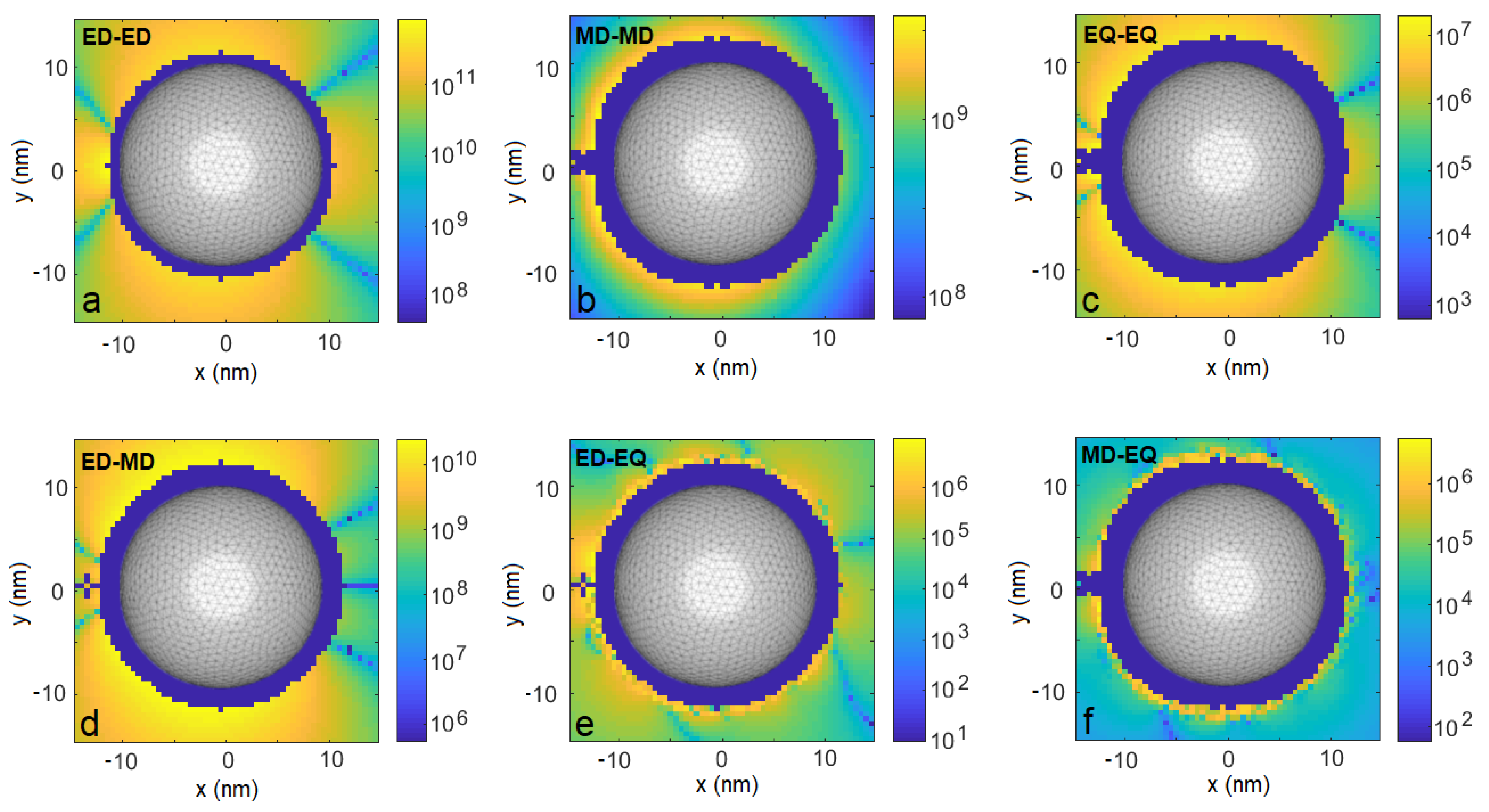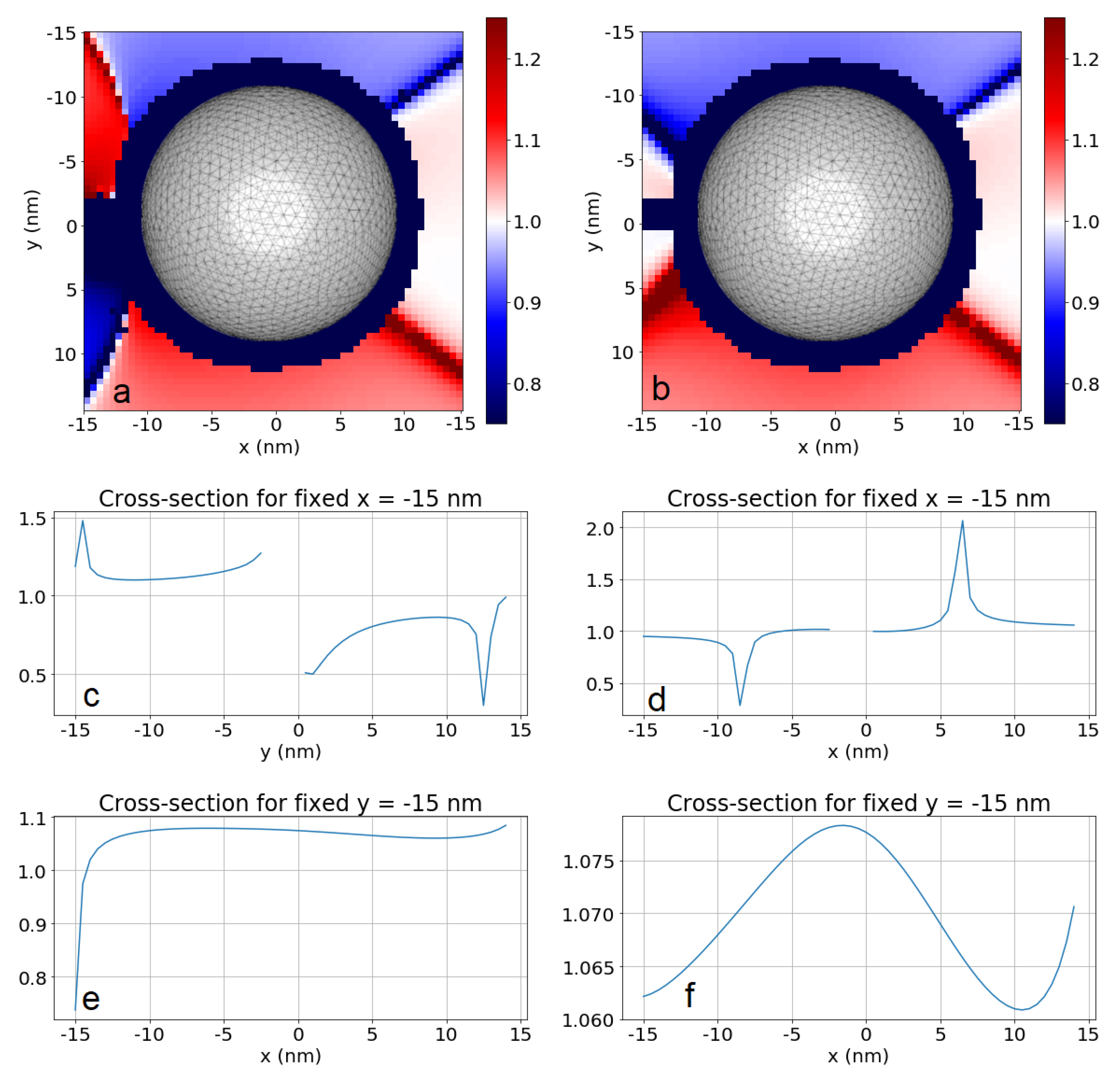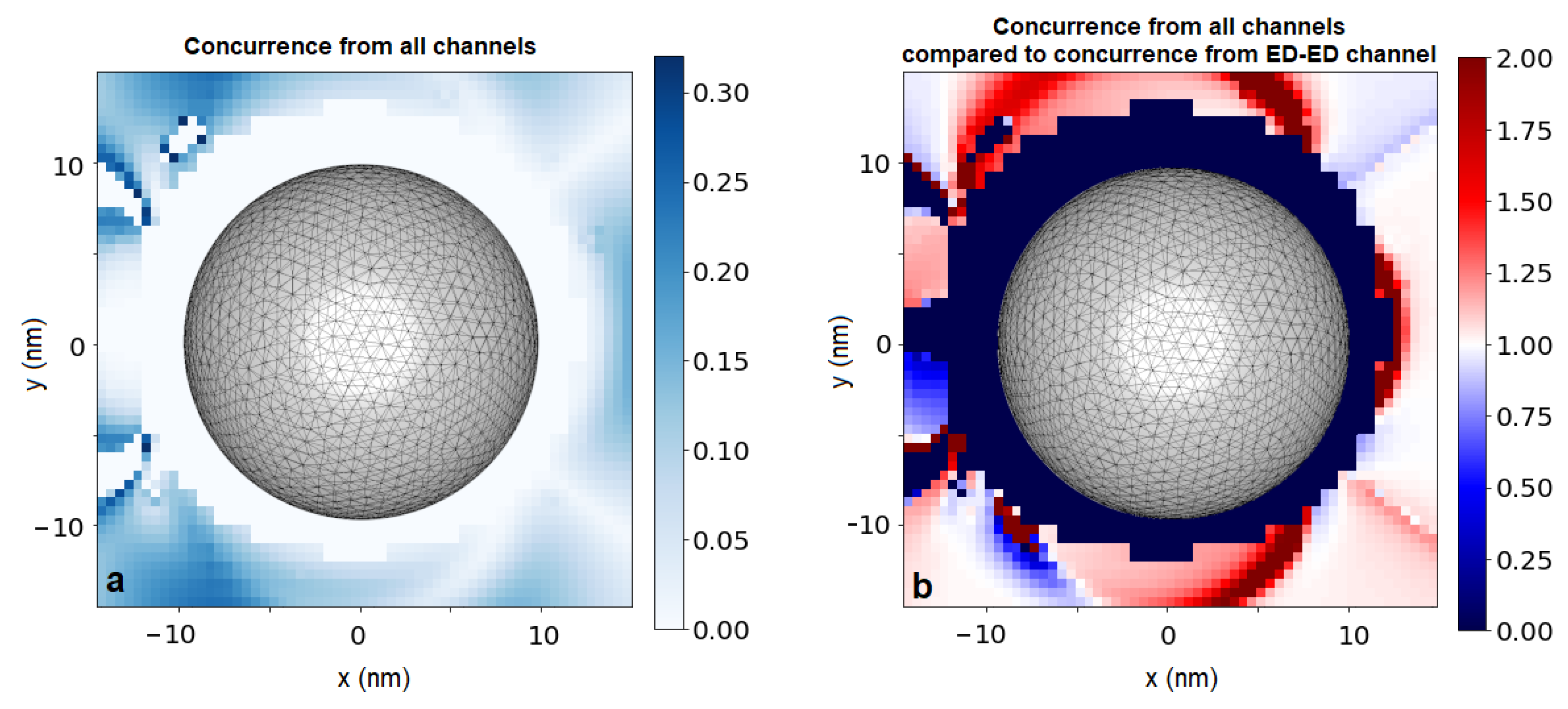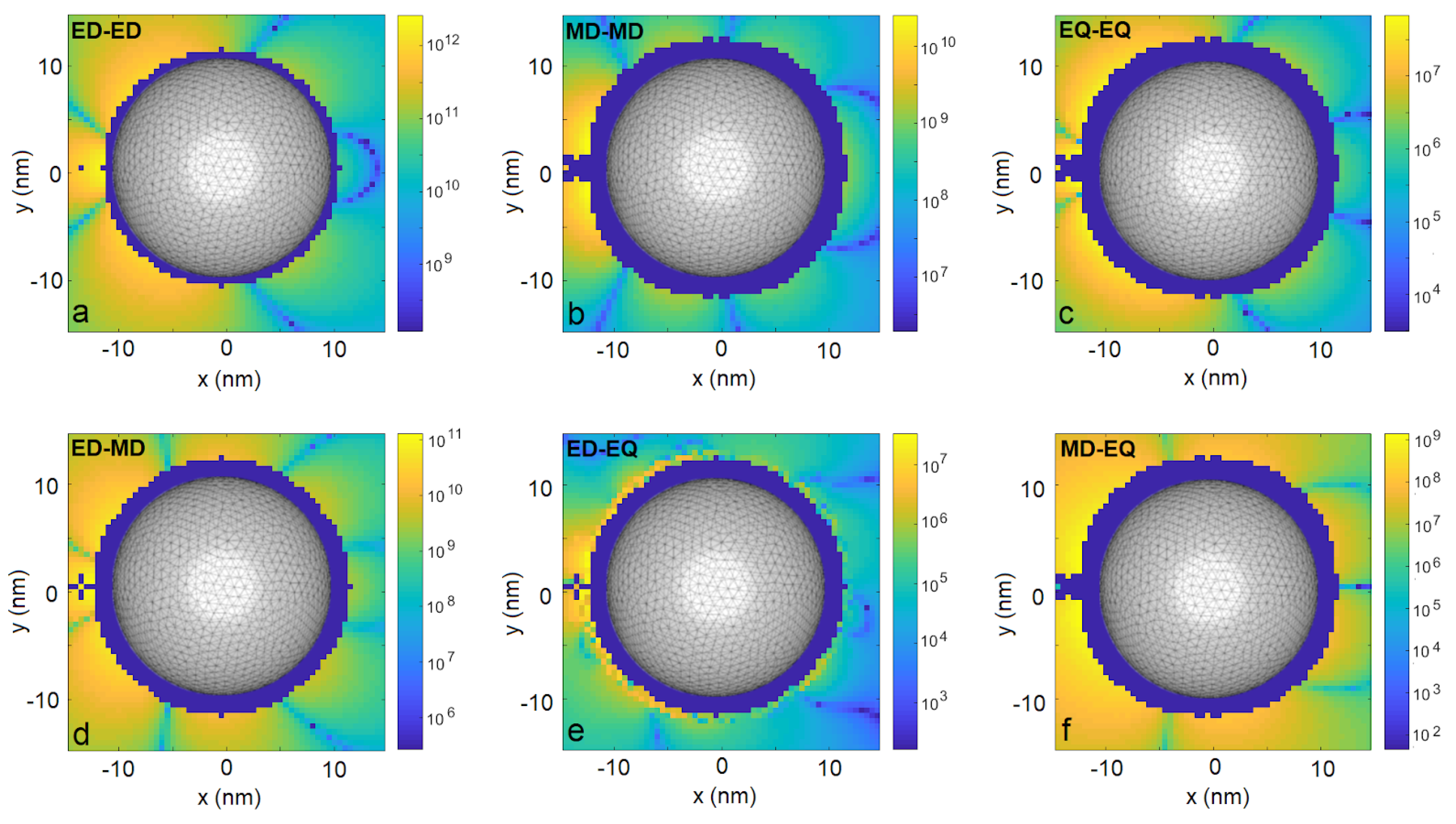Interaction and Entanglement of a Pair of Quantum Emitters near a Nanoparticle: Analysis beyond Electric-Dipole Approximation
Abstract
1. Introduction
2. Results
2.1. System
- The quantum vacuum is a background, playing the role of a carrier of the interactions of the quantum emitters. In open systems like the one considered in this work, this part of the field is tricky to keep track of, since it involves a continuum of optical modes. However, in this case, the quantum vacuum surrounding the emitters can be treated as a reservoir shared between the quantum emitters [16]. Then, it can be eliminated from the evolution equations of the system, leading to an effective picture as given below. The effective picture is obtained in the Markovian approximation, based on the assumption (which is well met in most practical cases) that at considered timescales, the light–matter coupling introduces only a small perturbation to the free dynamics of the field and of the emitter (for rigorous derivations and detailed discussions please see [23,36]). Under the Markovian approximation, one arrives at an effective form of equations describing the evolution of the emitters alone, in which contributions from Lamb shifts and spontaneous emission rates can be distinguished for individual emitters, and additionally, direct multipole–multipole interactions and collective decay effects arise between multiple emitters. These effects already arise in free space, but can be significantly enhanced and modified in the presence of plasmonic nanoparticles tailoring the properties of the quantum vacuum, quantified with the Green’s tensor. Please note that the coupling effect holds even if the frequencies of the emitters are not identical, as long as their difference is much smaller than the width of the plasmonic resonance;
- The classical drive is the source of energy in the setup and therefore is necessary to enable stationary entanglement generation. The energy it provides trades off various decay channels described below. Without the drive, the stationary state of the system would be the ground state, which is separable.
2.2. Hamiltonian and Liouvillan
- “Pure” coupling channels, in which the electric-dipole moment of the emitter interacts with the electric field originating from the electric-dipole moment of the emitter , the magnetic-dipole moment of the emitter is coupled to the magnetic field generated by the magnetic-dipole moment of the emitter , and the electric-quadrupole moment of the emitter - to the modulations of the electric field originating from the electric-quadrupole source corresponding to the emitter ;
- “Mixed” coupling channels related to interference, for example, an electric-dipole moment of the th emitter coupled to the electric field generated by the magnetic dipole or electric-quadrupole sources related to the emitter , etc.
2.3. Application
- The Green’s tensor corresponding to the particular geometry under study should be found. Here, and for single-emitter effects, while , and for collective effects, are respectively positions of the probe and the source as well as their frequencies. For this purpose, we have used a freely-available MATLAB solver MNPBEM, as described in the Materials and Methods section;
- Relevant derivatives of the Green’s tensor should be evaluated according to the orientations of the multipolar moments (Equation (9)). The first derivatives correspond to the interference terms involving the electric-dipole component, while the second derivatives are related to the magnetic dipole and electric-quadrupole components. Description of higher-order components would require a generalization of the method;
- To evaluate the degree of stationary entanglement in terms of concurrence, one needs to insert the effective-Hamiltonian/Liouvillian parameters, calculated above, to Equation (14) for the stationary density matrix. The concurrence can be found directly according to the recipe in Equation (15). These derivatives scaled by the multipolar moments determine the emitter–emitter interaction strengths and decay rates, according to Formulas (7), (10) and (11).
3. Discussion
4. Materials and Methods
Author Contributions
Funding
Conflicts of Interest
References
- Fischer, H.; Martin, O.J. Engineering the optical response of plasmonic nanoantennas. Opt. Express 2008, 16, 9144–9154. [Google Scholar] [CrossRef] [PubMed]
- Schuller, J.A.; Barnard, E.S.; Cai, W.; Jun, Y.C.; White, J.S.; Brongersma, M.L. Plasmonics for extreme light concentration and manipulation. Nat. Mater. 2010, 9, 193. [Google Scholar] [CrossRef] [PubMed]
- Gramotnev, D.K.; Bozhevolnyi, S.I. Plasmonics beyond the diffraction limit. Nat. Photonics 2010, 4, 83. [Google Scholar] [CrossRef]
- Tame, M.S.; McEnery, K.; Özdemir, Ş.; Lee, J.; Maier, S.; Kim, M. Quantum plasmonics. Nat. Phys. 2013, 9, 329–340. [Google Scholar] [CrossRef]
- Słowik, K.; Filter, R.; Straubel, J.; Lederer, F.; Rockstuhl, C. Strong coupling of optical nanoantennas and atomic systems. Phys. Rev. B 2013, 88, 195414. [Google Scholar] [CrossRef]
- Straubel, J.; Sarniak, R.; Rockstuhl, C.; Słowik, K. Entangled light from bimodal optical nanoantennas. Phys. Rev. B 2017, 95, 085421. [Google Scholar] [CrossRef]
- Chikkaraddy, R.; De Nijs, B.; Benz, F.; Barrow, S.J.; Scherman, O.A.; Rosta, E.; Demetriadou, A.; Fox, P.; Hess, O.; Baumberg, J.J. Single-molecule strong coupling at room temperature in plasmonic nanocavities. Nature 2016, 535, 127. [Google Scholar] [CrossRef]
- Yoshie, T.; Scherer, A.; Hendrickson, J.; Khitrova, G.; Gibbs, H.; Rupper, G.; Ell, C.; Shchekin, O.; Deppe, D. Vacuum Rabi splitting with a single quantum dot in a photonic crystal nanocavity. Nature 2004, 432, 200. [Google Scholar] [CrossRef]
- Barth, M.; Schietinger, S.; Schröder, T.; Aichele, T.; Benson, O. Controlled coupling of NV defect centers to plasmonic and photonic nanostructures. J. Lumin. 2010, 130, 1628–1634. [Google Scholar] [CrossRef]
- Purcell, E. Resonance Absorption by Nuclear Magnetic Moments in a Solid. Phys. Rev. 1946, 69, 37. [Google Scholar] [CrossRef]
- Iwase, H.; Englund, D.; Vučković, J. Analysis of the Purcell effect in photonic and plasmonic crystals with losses. Opt. Express 2010, 18, 16546–16560. [Google Scholar] [CrossRef] [PubMed]
- Akselrod, G.M.; Argyropoulos, C.; Hoang, T.B.; Ciracì, C.; Fang, C.; Huang, J.; Smith, D.R.; Mikkelsen, M.H. Probing the mechanisms of large Purcell enhancement in plasmonic nanoantennas. Nat. Photonics 2014, 8, 835. [Google Scholar] [CrossRef]
- Milonni, P. The Quantum Vacuum: An Introduction to Quantum Electrodynamics; Academic Press: Cambridge, MA, USA, 1994. [Google Scholar]
- Barnett, S.M.; Huttner, B.; Loudon, R.; Matloob, R. Decay of excited atoms in absorbing dielectrics. J. Phys. B At. Mol. Opt. Phys. 1996, 29, 3763. [Google Scholar] [CrossRef]
- Novotny, L.; Hecht, B. Principles of Nano-Optics; Cambridge University Press: Cambridge, UK, 2012. [Google Scholar]
- Ficek, Z.; Tanaś, R.; Kielich, S. Quantum beats and superradiant effects in the spontaneous emission from two nonidentical atoms. Phys. A Stat. Mech. Its Appl. 1987, 146, 452–482. [Google Scholar] [CrossRef]
- Dzsotjan, D.; Kästel, J.; Fleischhauer, M. Dipole-dipole shift of quantum emitters coupled to surface plasmons of a nanowire. Phys. Rev. B 2011, 84, 075419. [Google Scholar] [CrossRef]
- Martin-Cano, D.; González-Tudela, A.; Martín-Moreno, L.; Garcia-Vidal, F.; Tejedor, C.; Moreno, E. Dissipation-driven generation of two-qubit entanglement mediated by plasmonic waveguides. Phys. Rev. B 2011, 84, 235306. [Google Scholar] [CrossRef]
- Sinha, K.; Venkatesh, B.P.; Meystre, P. Collective effects in Casimir-Polder forces. Phys. Rev. Lett. 2018, 121, 183605. [Google Scholar] [CrossRef]
- Hou, J.; Słowik, K.; Lederer, F.; Rockstuhl, C. Dissipation-driven entanglement between qubits mediated by plasmonic nanoantennas. Phys. Rev. B 2014, 89, 235413. [Google Scholar] [CrossRef]
- Dung, H.T.; Knöll, L.; Welsch, D.G. Three-dimensional quantization of the electromagnetic field in dispersive and absorbing inhomogeneous dielectrics. Phys. Rev. A 1998, 57, 3931. [Google Scholar] [CrossRef]
- Scheel, S.; Knöll, L.; Welsch, D.G. Spontaneous decay of an excited atom in an absorbing dielectric. Phys. Rev. A 1999, 60, 4094. [Google Scholar] [CrossRef]
- Dzsotjan, D.; Sørensen, A.S.; Fleischhauer, M. Quantum emitters coupled to surface plasmons of a nanowire: A Green’s function approach. Phys. Rev. B 2010, 82, 075427. [Google Scholar] [CrossRef]
- Rolly, B.; Bebey, B.; Bidault, S.; Stout, B.; Bonod, N. Promoting magnetic dipolar transition in trivalent lanthanide ions with lossless Mie resonances. Phys. Rev. B 2012, 85, 245432. [Google Scholar] [CrossRef]
- Hein, S.M.; Giessen, H. Tailoring magnetic dipole emission with plasmonic split-ring resonators. Phys. Rev. Lett. 2013, 111, 026803. [Google Scholar] [CrossRef] [PubMed]
- Tighineanu, P.; Andersen, M.L.; Sørensen, A.S.; Stobbe, S.; Lodahl, P. Probing electric and magnetic vacuum fluctuations with quantum dots. Phys. Rev. Lett. 2014, 113, 043601. [Google Scholar] [CrossRef] [PubMed]
- Rivera, N.; Kaminer, I.; Zhen, B.; Joannopoulos, J.D.; Soljačić, M. Shrinking light to allow forbidden transitions on the atomic scale. Science 2016, 353, 263–269. [Google Scholar] [CrossRef] [PubMed]
- Neuman, T.; Esteban, R.; Casanova, D.; García-Vidal, F.J.; Aizpurua, J. Coupling of molecular emitters and plasmonic cavities beyond the point-dipole approximation. Nano Lett. 2018, 18, 2358–2364. [Google Scholar] [CrossRef]
- Gonçalves, P.; Christensen, T.; Rivera, N.; Jauho, A.P.; Mortensen, N.A.; Soljačić, M. Plasmon-Emitter Interactions at the Nanoscale. arXiv 2019, arXiv:1904.09279. [Google Scholar] [CrossRef]
- Karaveli, S.; Zia, R. Strong enhancement of magnetic dipole emission in a multilevel electronic system. Opt. Lett. 2010, 35, 3318–3320. [Google Scholar] [CrossRef]
- Taminiau, T.H.; Karaveli, S.; Van Hulst, N.F.; Zia, R. Quantifying the magnetic nature of light emission. Nat. Commun. 2012, 3, 979. [Google Scholar] [CrossRef]
- Aigouy, L.; Cazé, A.; Gredin, P.; Mortier, M.; Carminati, R. Mapping and quantifying electric and magnetic dipole luminescence at the nanoscale. Phys. Rev. Lett. 2014, 113, 076101. [Google Scholar] [CrossRef]
- Kasperczyk, M.; Person, S.; Ananias, D.; Carlos, L.D.; Novotny, L. Excitation of magnetic dipole transitions at optical frequencies. Phys. Rev. Lett. 2015, 114, 163903. [Google Scholar] [CrossRef] [PubMed]
- Li, D.; Karaveli, S.; Cueff, S.; Li, W.; Zia, R. Probing the Combined Electromagnetic Local Density of Optical States with Quantum Emitters Supporting Strong Electric and Magnetic Transitions. Phys. Rev. Lett. 2018, 121, 227403. [Google Scholar] [CrossRef] [PubMed]
- Rusak, E.; Straubel, J.; Gładysz, P.; Göddel, M.; Kędziorski, A.; Kühn, M.; Weigend, F.; Rockstuhl, C.; Słowik, K. Tailoring the Enhancement of and Interference among Higher Order Multipole Transitions in Molecules with a Plasmonic Nanoantenna. arXiv 2019, arXiv:1905.08482. [Google Scholar]
- Kosik, M.; Burlayenko, O.; Fernandez-Corbaton, I.; Rockstuhl, C.; Słowik, K. Interaction of atomic systems with quantum vacuum beyond electric dipole approximation. arXiv 2019, arXiv:1911.06166. [Google Scholar]
- Haakh, H.R.; Martín-Cano, D. Squeezed light from entangled nonidentical emitters via nanophotonic environments. ACS Photonics 2015, 2, 1686–1691. [Google Scholar] [CrossRef]
- Barron, L.D.; Gray, C.G. The multipole interaction Hamiltonian for time dependent fields. J. Phys. A Math. Nucl. Gen. 1973, 6, 59. [Google Scholar] [CrossRef]
- Masters, B. Paths to Förster’s resonance energy transfer (FRET) theory. Eur. Phys. J. H 2014, 39, 87–139. [Google Scholar] [CrossRef]
- Nelson, P.C. The role of quantum decoherence in FRET. Biophys. J. 2018, 115, 167–172. [Google Scholar] [CrossRef]
- Ferri, C.; Inman, R.; Rich, B.; Gopinathan, A.; Khine, M.; Ghosh, S. Plasmon-induced enhancement of intra-ensemble FRET in quantum dots on wrinkled thin films. Opt. Mater. Express 2013, 3, 383–389. [Google Scholar] [CrossRef]
- Zhang, X.; Marocico, C.A.; Lunz, M.; Gerard, V.A.; Gun’ko, Y.K.; Lesnyak, V.; Gaponik, N.; Susha, A.S.; Rogach, A.L.; Bradley, A.L. Experimental and theoretical investigation of the distance dependence of localized surface plasmon coupled Forster resonance energy transfer. ACS Nano 2014, 8, 1273–1283. [Google Scholar] [CrossRef]
- Li, J.; Cushing, S.K.; Meng, F.; Senty, T.R.; Bristow, A.D.; Wu, N. Plasmon-induced resonance energy transfer for solar energy conversion. Nat. Photonics 2015, 9, 601. [Google Scholar] [CrossRef]
- Dicke, R.H. Coherence in spontaneous radiation processes. Phys. Rev. 1954, 93, 99. [Google Scholar] [CrossRef]
- Lindblad, G. On the generators of quantum dynamical semigroups. Commun. Math. Phys. 1976, 48, 119–130. [Google Scholar] [CrossRef]
- Gorini, V.; Kossakowski, A.; Sudarshan, E.C.G. Completely positive dynamical semigroups of N-level systems. J. Math. Phys. 1976, 17, 821–825. [Google Scholar] [CrossRef]
- Hill, S.; Wootters, W.K. Entanglement of a pair of quantum bits. Phys. Rev. Lett. 1997, 78, 5022. [Google Scholar] [CrossRef]
- Johnson, P.B.; Christy, R.W. Optical Constants of the Noble Metals. Phys. Rev. B 1972, 6, 4370–4379. [Google Scholar] [CrossRef]
- Hohenester, U.; Trügler, A. MNPBEM–A Matlab toolbox for the simulation of plasmonic nanoparticles. Comput. Phys. Commun. 2012, 183, 370–381. [Google Scholar] [CrossRef]
- Kern, A.; Martin, O.J. Strong enhancement of forbidden atomic transitions using plasmonic nanostructures. Phys. Rev. A 2012, 85, 022501. [Google Scholar] [CrossRef]
- Filter, R.; Mühlig, S.; Eichelkraut, T.; Rockstuhl, C.; Lederer, F. Controlling the dynamics of quantum mechanical systems sustaining dipole-forbidden transitions via optical nanoantennas. Phys. Rev. B 2012, 86, 035404. [Google Scholar] [CrossRef]
- Yannopapas, V.; Paspalakis, E. Giant enhancement of dipole-forbidden transitions via lattices of plasmonic nanoparticles. J. Mod. Opt. 2015, 62, 1435–1441. [Google Scholar] [CrossRef]
- Wu, T.; Zhang, W.; Wang, R.; Zhang, X. A giant chiroptical effect caused by the electric quadrupole. Nanoscale 2017, 9, 5110–5118. [Google Scholar] [CrossRef]
- Schmidt, M.K.; Esteban, R.; Sáenz, J.; Suárez-Lacalle, I.; Mackowski, S.; Aizpurua, J. Dielectric antennas-a suitable platform for controlling magnetic dipolar emission. Opt. Express 2012, 20, 13636–13650. [Google Scholar] [CrossRef] [PubMed]
- Staude, I.; Miroshnichenko, A.E.; Decker, M.; Fofang, N.T.; Liu, S.; Gonzales, E.; Dominguez, J.; Luk, T.S.; Neshev, D.N.; Brener, I.; et al. Tailoring directional scattering through magnetic and electric resonances in subwavelength silicon nanodisks. ACS Nano 2013, 7, 7824–7832. [Google Scholar] [CrossRef] [PubMed]
- Bakker, R.M.; Permyakov, D.; Yu, Y.F.; Markovich, D.; Paniagua-Domínguez, R.; Gonzaga, L.; Samusev, A.; Kivshar, Y.; Luk’yanchuk, B.; Kuznetsov, A.I. Magnetic and electric hotspots with silicon nanodimers. Nano Lett. 2015, 15, 2137–2142. [Google Scholar] [CrossRef] [PubMed]
- Guo, R.; Rusak, E.; Staude, I.; Dominguez, J.; Decker, M.; Rockstuhl, C.; Brener, I.; Neshev, D.N.; Kivshar, Y.S. Multipolar coupling in hybrid metal–dielectric metasurfaces. ACS Photonics 2016, 3, 349–353. [Google Scholar] [CrossRef]
- Kuznetsov, A.I.; Miroshnichenko, A.E.; Brongersma, M.L.; Kivshar, Y.S.; Luk’yanchuk, B. Optically resonant dielectric nanostructures. Science 2016, 354, aag2472. [Google Scholar] [CrossRef]





© 2020 by the authors. Licensee MDPI, Basel, Switzerland. This article is an open access article distributed under the terms and conditions of the Creative Commons Attribution (CC BY) license (http://creativecommons.org/licenses/by/4.0/).
Share and Cite
Kosik, M.; Słowik, K. Interaction and Entanglement of a Pair of Quantum Emitters near a Nanoparticle: Analysis beyond Electric-Dipole Approximation. Entropy 2020, 22, 135. https://doi.org/10.3390/e22020135
Kosik M, Słowik K. Interaction and Entanglement of a Pair of Quantum Emitters near a Nanoparticle: Analysis beyond Electric-Dipole Approximation. Entropy. 2020; 22(2):135. https://doi.org/10.3390/e22020135
Chicago/Turabian StyleKosik, Miriam, and Karolina Słowik. 2020. "Interaction and Entanglement of a Pair of Quantum Emitters near a Nanoparticle: Analysis beyond Electric-Dipole Approximation" Entropy 22, no. 2: 135. https://doi.org/10.3390/e22020135
APA StyleKosik, M., & Słowik, K. (2020). Interaction and Entanglement of a Pair of Quantum Emitters near a Nanoparticle: Analysis beyond Electric-Dipole Approximation. Entropy, 22(2), 135. https://doi.org/10.3390/e22020135




